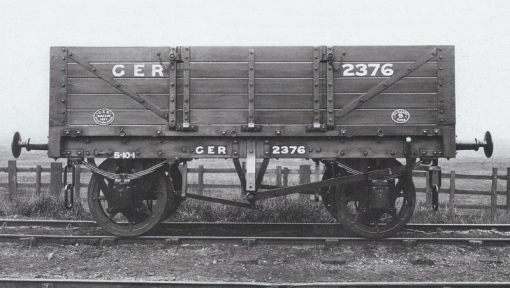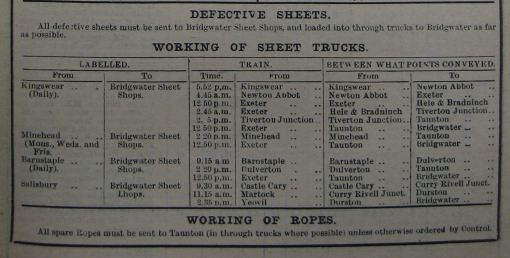James Holden’s five-plank open to Diagram 16 was a direct continuation of Worsdell’s four-plank wagon, the overall dimensions remaining the same including the interior depth of 2′ 10¾”.

Apart from the extra plank, Holden’s Diagram 16 9 ton 5-plank opens were virtually identical to their 4-plank predecessor built by Worsdell. Modernisations include the Holden E-Type grease axleboxes and full-length buffer guides obviating the need for wooden packing pieces. One of the first in service, no.2376, was photographed in 1887, straight from the paintshop, in the livery that lasted until 1902.
Photograph ©Public Domain
Conflicting statements have been made in documents concerning the date this new design was introduced as being either 1885 or 1887, and the total number of wagons built down to 1893 as either 3640 or 3740. The General Arrangement drawing is dated 1887, which actually solves nothing as Stratford often produced GAs after the introduction of an item of rolling stock, but it does mean that Stratford GAs are often a useful record of what was actually built, rather than the intent of the designer. As with the Worsdell wagon, a proportion of these wagons were set aside and put to use on loco coal duties over the GN & GE Joint Line until the advent of dedicated loco coal wagons in 1891, after which they were put into revenue earning service.
Despite retaining the same timber underframe as its predecessor, the new five-plank design made it into Holden’s Wagon Register in 1901 and was designated Diagram 16. This ensured the design had a longer lifespan by avoiding early obsolescence and withdrawal, and in consequence 3,000 examples were still in revenue-earning service at Grouping.
Livery details both pre-and post-1902 are exactly the same as for the earlier 4-plank open.
A 7mm kit exists for this wagon, which when I first encountered it in the mid-90s, was marketed by Wagon & Carriage Works, and is now in the hands of Powsides. As the prototype represented approximately 20% of the total wagon stock of the GER in at the start of the Basilica Fields timeframe 1890 (a total of 14,893 in revenue-earning service), they will be the the second most common wagon to appear on the layout after the subject of the next instalment of this mini series.
There is much conflicting evidence surrounding these non-diagrammed open wagons introduced in 1883 by T.W. Worsdell, but they were undoubtedly the first modern high-sided wagons on the Great Eastern Railway – all previous high capacity general merchandise wagons right back to the days of the Eastern Counties Railway had been constructed with archaic round ends.

Photographed near the end of it’s revenue-earning life, no.14297 sits in the short siding at Norton Folgate power station filled with scrap metal. The post-1903 livery is fairly evident. Behind it is a high sided wagon two generations away to Diagram 17. Photograph © Public Domain.
Until the end of 1883 most new wagons on the Great Eastern were supplied by contractors – only 200 out of 636 wagons ordered in 1883 were built at Stratford which instead concentrated on building specialised wagons, repairs and upgrades. However, continuing problems with contractor deliveries over the previous decade, coupled with the increase in traffic along the newly opened GN & GE Joint line prompted a change in policy. Concurrently, the Board had been monitoring the activities of the Midland Railway which was busy buying up private owner wagons (15,700 wagons by the end of 1883) and adding them to its own stock. All of these factors combined prompted the Great Eastern to follow the lead of the Great Northern Railway by increasing the building rate wagons suitable for both coal and general merchandise at its own works.
Therefore, in September 1883 Worsdell was instructed to arrange the building of 20 wagons a week, the open wagons costing a total of £112 7s 0d each including wheels and iron work. By the time the design was updated to a 5-plank version of identical proportions in 1885, at least 900 examples were in revenue earning service, 867 examples constructed in 1884 alone.
Initially a number of these wagons were allocated as carriers of loco coal, but following the introduction of the Diagram 31 7-plank loco coal wagon in 1891, most had been transferred back to general merchandise duties by the end of the following year.
The average life expectancy of a Great Eastern wagon was 35-40 years, but at the turn of the century, Worsdell’s successor, James Holden, began a rolling policy of removing timber-framed wagons from revenue earning service. In 1901 he complied a new Wagon Diagram Book and excluded this four-plank type, so they remained non-diagrammed to extinction. By the end of the Edwardian period great inroads had been made into withdrawing the wagons and none made it to Grouping except those taken into departmental service.
Measuring 15′ 0″ over headstocks and with a 9′ 6″ wheelbase, they were constructed with planks 2½” thick to an internal height of 2′ 10¾”, and incorporated side doors 5′ 2½” wide. Solebars were 12″ by 4″ timber and the headstocks measured 1′ 0″ by 5″. The wagons were fitted with contemporary short buffer castings that sat on 12″ square and 4″ thick wooden packing pieces bringing the total buffer length to 1′ 7″. The overall height of the wagons from the rail head was 7′ 1¼”.
A central strap on the side door dropped onto a steel door stop bolted to the solebar, protecting both the brake vee hanger and the door itself. Small rings along the sides of the curb rail and mounted on the second plank up on the ends were used for roping and securing protective sheets over goods. A hook was bolted to the left hand side of each solebar to enable horse and capstan shunting by rope or by chain.
Typical of the period, brakes were single side; one lever acting upon both wheels which were 3′ 1″ diameter and the built-up, split-spoked variety. Four-leaf springs and Type A grease axleboxes with cast iron spring stops completed the running gear.
From new these wagons were finished in the contemporary Great Eastern livery for general goods stock; slate grey (Humbrol 67 or Phoenix Precision P505. G.E.R Freight Wagon Grey are perfect matches), the iron work below the solebar, buffer guides, buffers, drawgear, drawbar plates and couplings were all painted black. Bodyside lettering consisted of the letters GER 5″ high on the second plank down on the left, with the running number on the same plank on the right hand side. 3″ lettering duplicated this information on the solebar either side of the vee hanger. A tare weight of circa 5-10-1 was painted in approximately 1½” numbers on the solebar over the left hand axlebox.
Separate elliptical makers and tonnage plates were fixed to the lowest planks on the left and right hand side, and these were 9″ x 7″ and 7¾” x 5¾” respectively.
From 1902 repainted wagons received new large GE lettering with the number on the lower left plank. Any wagons treated in that year would have received the short-lived square style of large letters, but from early 1903 the famous large, rounded style of lettering (as per the photo above) was applied and lasted until Grouping. The large initials were 24″ by 20″ and the running number 6⅞” high. The elliptical plates were moved up one plank to accommodate this change in style, and where applicable, the Cockers label clip on the lower right plank had a white box painted around it.
No kit exists for this wagon, but the Powsides kit of the virtually identical Diagram 16 5-plank open could be altered to represent the type. However, I’m seriously considering designing either an etched version or making a master for resin casting.
Quirky Questions No.8 “Covering up (in) the Past” is about a simple and important aspect of goods services… how were wagon sheets, and the ropes which secured those sheets to open wagons, managed within and between railway companies? Modellers with a hankering for the Midland Railway are served well by an excellent article in issue no.3 of the Midland Record journal (Wild Swan). Other railways are not so well served as the Midland Rlwy. hence the request for information within Quirky Query No.8.
An initial response has been posted to the GWR E-list (a Yahoo Group) which reminds us that a GWR Sheet Store was at Worcester – clearly something to be pursued. Thanks to John Greenough who is an ex-pat in the Antipodes.
Graham
Edit the first
An extract from the GWR WTT/STT section no.5, 1925, courtesy of Brian Bailey.

Now this is a conundrum… how to ask a small and simple question about a subject which is so little considered and yet was of such importance to the carriage of goods in the late 19th century… and a subject which was relevant to all railway companies since wagons from most (any?) of those companies could have been seen on the Extended Widened Lines. OK, possibly wagons of the North London Railway might not have penetrated the gloom of those hallowed tracks.. maybe a reader can offer a plausible scenario for NLR wagons working over the EWL?
So to the subject of this post… sheets ands ropes, required in their thousands for covering and protecting goods in transit when carried in open wagons.
Much has been written about how the railway companies managed the movement of loaded and empty wagons…. and about how the Railway Clearing House kept records of foreign* wagon movements between railway companies…. little has been written about the management and return of the sheets and ropes which would have made similar journeys across railway boundaries. A good explaination of how the Midland Railway (and its successors) managed wagon sheets and associated ropes is provided by Midland Record No.3 (Wild Swan)… good enough to prompt investigation into how things were done on other railways. Such a task seems necessary to the working of goods services through Basicilia Fields and yet such a task is onerous in the extreme.
How can readers of this journal assist? Initially, by contributing to what is known and where such information is recorded relating to wagon sheets / ropes for those railway companies whose wagons are likely to form the bulk of the goods stock working over the Extended Widened Lines. Please feel free to provide such details by comments to the Quirky Answers post for this subject. Our initial thoughts are that such wagons are likely to come from the following companies:-
* Great Central Railway;
* Great Eastern Railway;
* Great Northern Railway;
* Great Western Railway;
* London and North Western Railway;
* Manchester, Sheffield and Lincolnshire Railway;
* Metropolitan Railway;
* Midland Railway (recorded in Midland Record No.3).
thank you, Graham
[BTW – information received on this subject is available in “Querky Answers – Sheets and Ropes“]
* foreign in this context means a wagon owned by railway company “A” working over the tracks of railway company “B”.


